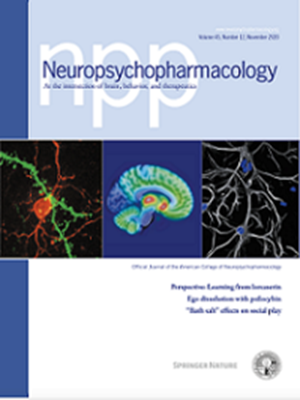咖啡因和大麻二酚(CBD)共同给药对Δ9-tetrahydrocannabinol (Δ9-THC)主观效应、行为障碍和药代动力学的影响。
IF 6.6
1区 医学
Q1 NEUROSCIENCES
引用次数: 0
摘要
在美国市场上,预混咖啡因的大麻产品越来越多。尽管出现了这类产品,但没有人类实验室数据直接评估咖啡因对Δ9-tetrahydrocannabinol (Δ9-THC)效果的单独影响,以及其他共同使用的大麻素的额外影响。这项双盲、随机、安慰剂对照、受试者内交叉研究评估了Δ9-THC、咖啡因和大麻二酚(CBD)之间潜在的药效学和药代动力学相互作用。参与者(N = 20; 10名男性/10名女性)完成门诊实验室疗程,其中口服Δ9-THC(累积7.5毫克),咖啡因(累积180毫克)和/或CBD(累积105毫克)在累积剂量设计中共同给予。主要结果包括表明滥用责任的主观影响(例如,药物高),安全风险基础的表现影响(例如,模拟驾驶)和血浆大麻素/咖啡因浓度。咖啡因联合服用对Δ9-THC-induced的主观影响、表现或代谢的影响很小,尽管观察到了感知驾驶障碍的信号。相比之下,与Δ9-THC单独使用相比,当CBD与Δ9-THC和咖啡因联合使用时,与滥用责任(例如,药物兴奋,p = 0.002)和表现障碍相关的结果增加。CBD也增加血浆Δ9-THC (p = 0.004)和11-OH-Δ9-THC (p = 0.004)本文章由计算机程序翻译,如有差异,请以英文原文为准。

Effect of caffeine and cannabidiol (CBD) co-administration on Δ9-tetrahydrocannabinol (Δ9-THC) subjective effects, performance impairment, and pharmacokinetics
Cannabis products premixed with caffeine are increasingly present in the United States marketplace. Despite emergence of this product class, no human laboratory data have directly evaluated the isolated impact of caffeine on Δ9-tetrahydrocannabinol (Δ9-THC) effects as well as additional impacts of other common co-administered cannabinoids. This double-blind, randomized, placebo-controlled, within-subject crossover study evaluated potential pharmacodynamic and pharmacokinetic interactions between/among Δ9-THC, caffeine, and cannabidiol (CBD). Participants (N = 20; 10 men/10 women) completed outpatient laboratory sessions in which oral Δ9-THC (7.5 mg cumulative), caffeine (180 mg cumulative), and/or CBD (105 mg cumulative) were co-administered in a cumulative dosing design. Primary outcomes included subjective effects indicative of abuse liability (e.g., drug high), performance effects that underlie safety risk (e.g., simulated driving), and plasma cannabinoid/caffeine concentrations. Caffeine co-administration produced minimal changes in Δ9-THC-induced subjective effects, performance, or metabolism, although signals for perceived driving impairment were observed. In contrast, CBD, when co-administered with Δ9-THC and caffeine increased outcomes associated with abuse liability (e.g., drug high, p = 0.002) and performance impairment versus Δ9-THC alone. CBD also increased plasma Δ9-THC (p = 0.004) and 11-OH-Δ9-THC (p < 0.001) concentrations compared with dose conditions without CBD co-administration. These data provide the first direct assessment of the pharmacodynamic and pharmacokinetic effects of Δ9-THC and caffeine when co-administered in humans. The robust alteration of Δ9-THC-induced effects and Δ9-THC pharmacokinetics by CBD further emphasizes the importance of considering full cannabinoid profiles. Broadly, these data highlight the importance of considering drug combinations and interactions in future cannabis regulatory decision-making.
求助全文
通过发布文献求助,成功后即可免费获取论文全文。
去求助
来源期刊

Neuropsychopharmacology
医学-精神病学
CiteScore
15.00
自引率
2.60%
发文量
240
审稿时长
2 months
期刊介绍:
Neuropsychopharmacology is a reputable international scientific journal that serves as the official publication of the American College of Neuropsychopharmacology (ACNP). The journal's primary focus is on research that enhances our knowledge of the brain and behavior, with a particular emphasis on the molecular, cellular, physiological, and psychological aspects of substances that affect the central nervous system (CNS). It also aims to identify new molecular targets for the development of future drugs.
The journal prioritizes original research reports, but it also welcomes mini-reviews and perspectives, which are often solicited by the editorial office. These types of articles provide valuable insights and syntheses of current research trends and future directions in the field of neuroscience and pharmacology.
 求助内容:
求助内容: 应助结果提醒方式:
应助结果提醒方式:


